Barefoot
Barefoot is the most common term for the state of not wearing any footwear.
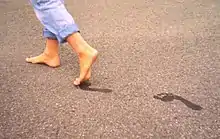
.jpg.webp)
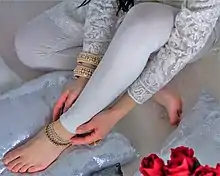
.jpg.webp)
Wearing footwear is an exclusively human characteristic, however some animals held by humans are also issued with footwear, such as horses and, more rarely, dogs and cats. There are health benefits and some risks associated with going barefoot. Footwear provides protection from cuts, abrasions, bruises, and impacts from objects on the ground or the ground texture itself, as well as from frost or heat burns, and parasites like hookworm in extreme situations. However, shoes can limit the flexibility, strength, and mobility of the foot and can lead to higher incidences of flexible flat foot, bunions, hammer toe, and Morton's neuroma. Walking and running barefoot results in a more natural gait, allowing for a more rocking motion of the foot, eliminating the hard heel strike and therefore generating less collision force in the foot and lower leg.[1][2]
There are many sports that are performed barefoot, most notably gymnastics and martial arts, but also beach volleyball, swimming, barefoot running, barefoot hiking, and water skiing. Certain situations can however determine people to be barefoot against their will mainly for reasons of precaution, identification or punishment, for example during incarceration. In modern language, someone who tends not to wear shoes in public, is participating in the aforementioned sports or goes unshod either for religious or punitive reasons may be described as a barefooter or equivalents in other languages (for example German "Barfüßer" or Italian "scalzo").[3][4]
Historical and religious aspects
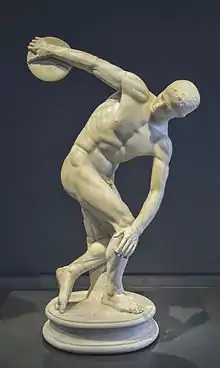
People in ancient times, such as the Egyptians, Hindus, and Greeks often went barefoot, as the inhabited terrain mostly mandated no practical necessity for footwear. The Egyptians and Hindus made some use of ornamental footwear, such as a soleless sandal known as a Cleopatra, which did not provide any practical protection for the foot. Athletes in the Ancient Olympic Games participated barefoot and generally unclothed.[5] Even the gods and heroes were primarily depicted barefoot.
The Romans, who eventually conquered the Greeks and adopted many aspects of their culture, did not adopt the Greek perception of footwear and clothing. Roman clothing explicitly including footwear was seen as a sign of power and as a necessity of living in a civilized world; accordingly slaves usually were to remain barefoot.[6] There are many references to shoes being worn in the Bible. During weddings of this period, a father would give his son-in-law a pair of shoes to symbolize the transfer of authority.[7]
During the Middle Ages, both men and women wore pattens in Europe, commonly seen as the predecessor of the modern high-heeled shoe,[8] while menial classes usually wore hand-made footwear made from whatever materials were available. Going barefoot was seen as a mark of poverty and the lowest social class, as well as being the mark of a prisoner.[6] In the 15th century, chopines were created in Turkey and were usually 7–8 inches (17.7–20.3 cm) high. These shoes became popular in Venice and throughout Europe as a status symbol revealing wealth and social standing. During the 16th century royalty, such as Catherine de Medici and Mary I of England, started wearing high-heeled shoes to make them look taller or larger than life. By 1580, even men wore them, and a person with authority or wealth was often referred to as "well-heeled".[8]
The phrase barefoot and pregnant is now used to illustrate a woman's traditional role as a homemaker and thus her lack of opportunities to socialize or to have a career outside of the home.[9] It was first used in the early 20th century, possibly by Arthur E. Hertzler (also known as the "Kansas Horse-and-Buggy Doctor"),[10] promoting a hypothesis that:[11]
The only way to keep a woman happy is to keep her barefoot and pregnant.
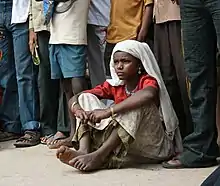
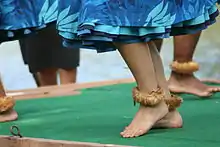
Bare feet have come to symbolize innocence or childhood in a glorifying perception of freedom from real-life requirements. The connection to childhood and innocence, as well as the simple joys of country life, are embodied in the poem "The Barefoot Boy" by John Greenleaf Whittier, published in 1855.[12] Additionally, the book Dancing Barefoot by Star Trek: The Next Generation actor Wil Wheaton features five short stories that chronicle his journey from childhood and youth through to maturity and self-acceptance.[13]
Religious aspects
In most religions, the exposure of bare feet is regarded as a sign of humility and subjection. Some religious practitioners have taken a vow of Gospel poverty, while there are certain convents where going barefoot is obligatory (Convent of Las Descalzas Reales, Poor Clares, Colettine Poor Clares). With regard to the use of footwear as a display of status, the religious and common art of many cultures throughout the world shows a person without shoes symbolizing either extreme poverty or the state of captivity and unfree servitude.[14] In Thailand, Master Jinshen, a Buddhist monk, walks 20 kilometers (12 mi) per day barefoot as a reminder to others who pursue a material life to protect and be concerned for Mother Nature. He states that he does this to follow Buddhist rules, to lead the people to the path of virtue, and to develop his Buddhist spirit.[15] It is customary in Judaism and some Christian denominations to go barefoot while mourning.[14] Some Christian churches practice barefoot pilgrimage traditions, such as the ascent of Croagh Patrick in Ireland at night while barefoot (although the nighttime part is no longer encouraged).[16]
In many religions, it is common to remove shoes when entering a place considered holy. For example, in the Book of Exodus, Moses was instructed to remove his shoes before approaching the burning bush:
Put off thy shoes from off thy feet, for the place whereon thou standest [is] holy ground (Exodus 3:5).
Anyone entering a mosque or a Hindu temple, including a visitor, is expected to remove his or her shoes; racks for the storage of shoes are usually provided at the entrance.[17][18]
Foot washing, or ceremonial washing of others' feet, is associated with humility in Christianity, and Jesus Christ is recorded in the New Testament as washing the feet of his disciples to serve them during the Last Supper. Christians who practice foot washing today do so to bring them closer to Jesus and to fill them with a sense of humility and service. Roman Catholics show their respect and humility for the Pope by kissing his feet. In a similar manner, Hindus show love and respect to a guru by touching his bare feet (called pranam). It is customary to show one's respect by walking barefoot around Raj Ghat, the monument to Mahatma Gandhi.[14] Both United States President George W. Bush and Pope John Paul II paid him this honor.[19] During the Imperial Japanese period, removing one's shoes in the presence of a person of higher status was a sign of showing one's own humility, subordination, and respect towards their status.[14]
Christian congregations of men and women that go entirely barefoot or wear sandals include the Discalced, like the Discalced Carmelites (1568), the Feuillants (Cistercians, 1575), the Trinitarians (1594), the Mercedarians (1604), and the Passionists.
In many branches of Romani culture across the world, it is traditional for women to dance barefoot.
Firewalking
Firewalking is the practice of walking barefoot over hot coals. It has been practiced by many people and cultures in all parts of the world, with the earliest known reference dating back to Iron Age India – c. 1200 BC.[20] It is often used as a rite of passage, as a test of an individual's strength and courage, or, in religion, as a test of one's faith. Today, it is often used in corporate and team-building seminars and self-help workshops as a confidence-building exercise. Firewalking implies the belief that the feat requires the aid of a supernatural force, strong faith, or on an individual's ability to focus on "mind over matter".[14] Modern physics has largely debunked this, showing that the amount of time the foot is in contact with the ground is not enough to induce a burn, combined with the fact that coal is not a very good conductor of heat.[20]
Barefoot customs by country
.jpg.webp)
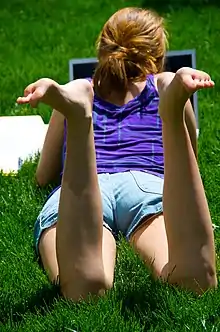
Australia
It is common for Australians, particularly young people, to be barefoot in public places, especially during summer.[21] McDonald's launched a summer advertisement in 2012 featuring a customer running barefoot through the hot carpark to the restaurant.[22] In some rural and remote areas, such as the Northern Territory, Western NSW, regional Queensland and many islands, students often attend school barefoot. On Lord Howe Island the Lord Howe Island Board has described the fact pupils at the government-run Lord Howe Island Central School are allowed to attend school barefoot as a part of the "island lifestyle" and a "community asset".[23]
Barefoot walking, known as 'earthing', has been used by the Australian cricket team to 'capture positive energy coming out of the earth.'[24]
India
In Indian culture, in many an instance, being barefoot has a cultural significance. For example, it is customary to remove footwear when entering a home or a temple so as shoes are considered impure. Indians also traditionally sit on the floor when eating meals as opposed to at a dining table, which would normally entail taking off footwear.[25][26]
New Zealand
In 2010, an American lecturer missed out on a job after criticising barefoot locals in a newspaper.[27] The lecturer wrote barefoot locals were "not only backward and uncivilised, but dangerously unhygienic and repulsive to North Americans" in response to an article mocking a no shoes, no service policy in Texas. In 2012, a travel writer for The New York Times wrote the number of New Zealanders barefoot in public, including shops was "striking".[28] Many expats in New Zealand have been surprised how many people, of all races and classes, carry on daily business barefoot.[29] In 2014, Air New Zealand was subject of critical attention after allegedly forcing a customer to wear shoes.[30]
South Africa
In South Africa barefoot walking in public is part of the predominantly white Afrikaans speaking culture, although English speaking people also often walk barefoot in public, especially in the summer months and in cities such as Cape Town. The National Guidelines on School Uniform list shoes as an optional item[31] while the Draft Guidelines state "Pupils, especially in lower grades, should also be permitted to attend without shoes in hot weather". Most children attend school barefoot. In many schools, the dress codes either encourage kids to attend school barefoot or prefer kids to attend school barefoot, especially in the summer months. Some South African schools have sport uniforms where bare feet are compulsory, such as primary school rugby. Another sport where bare feet for kids are compulsory is "tou trek" or tug of war. Being barefoot in public is generally tolerated. In South African shopping malls, stores, and events, it is not an uncommon sight to see barefoot adults, kids and especially teenagers and young adults.
United Kingdom
Being barefoot in public is more common during warmer months, and often accepted as a social norm, however this does not extend to metropolitan cities such as London, but more for rural areas and more common for young children and teenagers. Some British schools also allow children to attend school barefoot in warmer months, and encourage it for indoor and outdoor physical education lessons. The National Health Service has recommended that people "go barefoot or wear open-toed sandals whenever you can in the hot weather...to help stop your feet getting sweaty and smelly."[32]
United States
In some parts of the United States, where taboos against barefoot walking are strong, it is common for people to wear the same shoes indoors and outdoors, and for guests to keep their shoes on when visiting other people's houses. Youngstown, Ohio, actually did have an ordinance prohibiting barefooting until it was struck down as unconstitutional.[33] However, in the early 18th to 20th century many children in rural areas of America often went barefoot due to poverty. Many stores, restaurants, and other public venues in the United States employ dress codes prohibiting bare feet. While private business owners are free to set their own policies, many cite different health regulations, though these typically are occupational safety requirements that pertain to employees only.
Imprisonment and slavery
| Part of a series on |
| Slavery |
|---|
 |
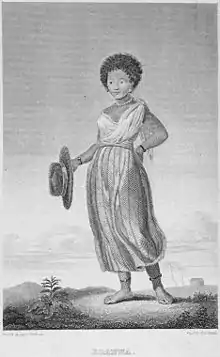

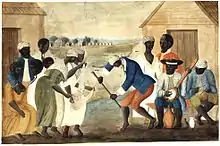
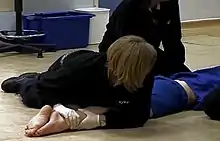
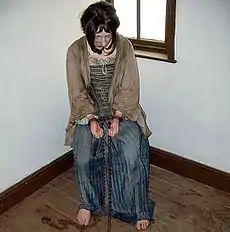
19th century (museum exhibit)

To Visit the Imprisoned, 1640s
.jpg.webp)
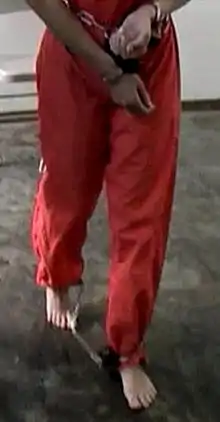
barefoot in high security restraints
Removing the footwear from a captive person and forcibly making him or her go barefoot has been one of the first means to identify prisoners and other unfree individuals such as slaves in most civilizations. Due to the fact that protective, as well as ornamental footwear, has consistently been a standard clothing feature since the era of ancient civilizations, the much more uncommon semblance of bare feet tends to stand out in apparent contrast to the usual public appearance. Hereby a certain degree of attention and curiosity is typically generated in an observer, which is often purposefully used to mark certain individuals as unfree.
The outward form of bare feet, especially of fully denuded toes, is readily distinguishable from that of regular footwear, which is the case from many different angles around the unshod person. Therefore imposing a barefoot rule and enforcing this specific form of appearance has been a principal feature of early and many modern prison uniforms as well as similar manifestations of typifying clothing for otherwise unfree or captive individuals. For example, female prisoners in 1940s Nazi-era Germany had to live under a strictly enforced barefoot rule in a number of different women's institutions. Bare feet were a compulsory element of their prison uniform and covering them in any way was a punishable offense for the imprisoned women.[34][35][36][37] This viable method to mark and identify prisoners is still employed by authorities in many countries of today.
Seizing the footwear and making an individual go barefoot by constraint is also commonly used in situations where captives cannot be outfitted with identifiable prisoner's clothing due to the circumstances. In those cases forcibly keeping the respective individuals in their bare feet is used as an option, if they are required to be flagged and singled out in an easily obtainable and sufficiently unambiguous manner.
The practice of keeping prisoners fully barefoot is also applicable to hinder and frustrate potential attempts of escape from any form of captivity. This is the case as the susceptible feet, especially the vulnerable soles and toes, are constantly exposed to potentially adverse conditions of the respective environment. It often proves drastically more difficult for prisoners to advance on any given escape route without having the sufficient protection of their feet. If detainees or captives attempt to flee in only their bare feet, this often does not allow for enough rapid and constant locomotion to evade potential pursuers. Through the usually self-evident awareness of this factor, escape attempts by involuntarily barefooted prisoners are often prevented altogether.
Going with bare feet naturally renders a person physically vulnerable and also drastically more susceptible to pain and any other form of discomfort caused by his or her immediate environment. For a shoeless individual the individual radius of action and his or her personal freedom is therefore restricted in many everyday situations, that are usually unproblematic for any shod person. As a consequence a forcibly barefooted individual, who is deprived of the possibility to put on shoes at will, is deliberately placed at a physical and through intimidation also psychological disadvantage against a shod person in many regards. The more protection fully clothed men and women receive from their footwear, the more decisive the immediate disadvantage of the barefooted person normally turns out to be. This aspect is often intentionally utilized by police and corrections, where their personnel is typically issued with highly functional protective gear. Removing the footwear off a person and hereby forcing him or her to remain barefoot is therefore routinely used by law enforcement authorities. This is the case as it offers an immediate and easily accessible option to contain and control an individual in any situation of detainment. In most cases the exercise of control can be achieved without the use of physical force as a detainee kept barefoot is hereby already put in a state of intimidation. This way the detainee is more readily compliant towards fully equipped prison or police officers, as he or she is almost constantly aware of this particular vulnerability and hereby typically coerced into submission. The method of keeping a prisoner barefoot usually complements other means to limit his or her radius of action and is often used in conjunction with restraints such as handcuffs and ankle shackles.
Due to the lack of any protection a barefooted individual usually finds him or herself at a stark disadvantage especially in manifestations of physical confrontation opposing a person wearing protective gear, especially closed footwear such as boots or other forms of safety shoes usually worn by law enforcement officers. Unlike a person with bare feet, drastically more severe injuries can be caused by a kicking person wearing shoes. This is the case because maximum possible force can be put into the motions of a shod kick with almost no factual risk of hurting the impacting foot in the act.[38] For this reason shoes are considered dangerous weapons by penal laws in different countries. One example is Germany.[39][40][41] As footwear can be misused to cause injury in this manner, it is also still a measure of precaution in a number of countries, not to issue prisoners with shoes at all but to keep them barefoot either throughout or for certain periods of time. In countries where prisoners are usually allowed to wear shoes, it is, however, commonplace to seize the footwear of detainees in potentially dangerous situations and also during intake procedures. Mentally unstable or incalculable inmates are usually forced to stay barefoot as well. This is accordingly done to safeguard detention staff from receiving injuries from a resisting person often struggling with his or her entire body, especially their legs and feet.
On the other side, bare feet are a common target for the application of force in situations of confrontation as they are overall highly pain-sensitive and usually within easy reach of the opponent. Moreover, the particular vulnerability of unprotected toes makes them an opportune target to exercise physical control over the barefooted person. These advantages are usually desired by correctional or police officers in situations with resisting arrestees or prisoners. Law enforcement techniques such as pain compliance can be used on bare feet in ways of toe-locks or painful bending of the toes. It is further possible to subdue a resister by applying pointed pressure to the unprotected soles of the person's bare feet, which present a high level of sensitivity. The vaults of the feet are particularly sensitive to pain due to the very tight clustering of nerve tissue. Thus the undersides of bare feet provide a multiplicity of spots for controlled application of force by a detention officer. Also by gripping the big toes of both feet and holding them firmly together an insubordinate prisoner can be practically immobilized and rendered harmless. It usually gets painful for the detained person, if he or she continues to struggle while being held in this toe-lock. With these enforcement techniques, a dangerous situation can usually be de-escalated without injury.[42]
Another main objective of keeping a prisoner barefoot can be seen in preventing and counteracting potential attempts of prison escape. Without effective protection against the environment that shoes usually provide, the locomotion of an unshod person is more difficult in the majority of exterior surroundings. This way a fugitive prisoner is easier to retrieve in many cases. Detainees are often discouraged from attempting escape by this measure alone.[43]
A barefoot person experiences certain discomfort in daily life situations. The desire to be protected from the common inconveniences of the ground, mostly due to coarse textures or adverse temperatures, prompted humans to make use of footwear in ancient history. Incidentally, the traditional visual appearance of civilized societies was established, including footwear as an obligatory feature. A forced exclusion from the conveniences and appearance of footwear typically creates the awareness of being vulnerable, therefore it often has an intimidating effect on a person. Forcing prisoners or other captives to go barefoot often induces a persistent consciousness of submission, as they cannot relieve this often adverse situation on their own.[44] The effect of intimidation is often compounded even further if the bare feet also serve as the target for methods of corporal punishment such as bastinado, which is the case in a number of countries where prisoners are regularly forced to stay barefoot.
As the practical effects are achieved effortlessly and without expenses, keeping prisoners, slaves or other captives barefoot has been cross-culturally practiced ever since antiquity.[45]
Slave codes
It has been a standard feature for common citizens in civil societies to wear shoes ever since ancient times. On the contrary slave codes often included that slaves had to remain barefoot as a matter of principle. For example, the Cape Town slave code stated that "Slaves must go barefoot and must carry passes."[46] This was the case in the majority of states that abolished slavery later in history, as most images from the respective historical period suggest that slaves were barefoot.[47] To quote Brother Riemer (1779): "[the slaves] are, even in their most beautiful suit, obliged to go barefoot. Slaves were forbidden to wear shoes. This was a prime mark of distinction between the free and the bonded and no exceptions were permitted." [48]
Shoes have been regarded as signs of empowerment and badges of freedom since early human history. Going barefoot, on the other hand, showcased a very low social status, often being an unfree person. Using the meaning of shoes to display a respectable social status and authority, people have sometimes been issued with footwear even ceremonially. This aspect is mentioned in the Bible, the Parable of the Prodigal Son quotes: "But the father said to his servants, Bring forth the best robe, and put [it] on him; and put a ring on his hand, and shoes on [his] feet (Luke 15:22)".
Forcing individuals to go barefoot by taking away their footwear and preventing or banning shoes from being worn therefore has the reversed meaning. While the standard form of appearance commonly includes footwear as a standard feature, the imagery or bare feet is often used to display submission, subjugation or dependence, in certain contexts also being disarmed or disempowered.
Therefore, this detail has become an informal and sometimes even formal law in societies practicing slavery in present and past. A barefooted individual could be unmistakably identified as unfree and therefore be attributed with the lowest social status, at first sight, being either a slave or a prisoner. As a consequence appearing barefoot in public was strictly avoided by common citizens.
In many states this perception is prevalent to this day and shoes are typically also worn in the private space while being barefoot is placed under taboo (see above).
In societies where slavery is still unofficially practiced this rule pertains to this day. For example, the Tuareg are known still to practice slavery and force their slaves to go barefoot.[49]
Imprisonment
In several countries of the world prisoners generally have to remain barefoot. This constraint serves the purpose of unmistakable identification and also places prisoners in a physical disadvantage against their warders. Keeping detainees with bare feet makes it more difficult for them to put up effectful resistance and to escape from custody.
Taking away the footwear from the imprisoned has been common practice throughout most urbanized societies since ancient history. This is the case as the desired results of marking and executing control over captive individuals are achieved almost effortlessly. As wearing shoes has long been established as the canonical standard, the display of bare feet is a widely recognizable and unmistakable indicator. As a result, going barefoot has become a typical characteristic of unfree individuals, commonly forced upon prisoners, but also prevalent as a distinctive feature in most times and places where slavery existed.
In historical periods such as the Middle Ages, where distinct footwear was used to display social status and rank, having to go shoeless by constraint was a severe form of degradation.[50] Forcing captives to go barefoot hereby constituted the earliest means of visually marking prisoners in terms of a prison uniform, while the practice itself dates back to antiquity when wearing shoes had become standard.
Today keeping prisoners barefoot is common practice in China,[51] Zimbabwe,[44][52][53] Thailand,[52][54][55] Uganda,[56][57][58] Iran,[59] Pakistan,[60] India,[61] Congo,[62] Malawi,[63] Rwanda,[64] Côte d’Ivoire (Ivory Coast),[65] and North Korea[66] among others.
The ISIS usually deprives their captives of footwear, presumably for identification purposes opposite the booted combatants as well as to prevent resistance and escape.[67]
In Thailand, a defendant must strictly be barefoot in court during the penal proceedings.[68][69][70][71][72][73]
In Germany it was usual practice during the Nazi-era to keep female prisoners barefoot. In work camps women also had to perform forced labor with bare feet, even under adverse weather conditions. This was done to reduce the cost for clothing items and also to contain and intimidate the captives.[14][35][74][75]
In women's prisons of East Germany especially political prisoners could have their footwear seized and be detained barefoot as an aggravation of their punishment.[76]
In parts of the United States it remained common practice until the 20th century to detain female prison inmates in their bare feet. Notably in Texas incarcerated women were standardly deprived of footwear by the enforcement authorities and had to remain barefoot during their imprisonment. This was contrasting the superior treatment of male incarcerees, who were standardly provided with solid footwear. The unequal handling was practiced to display the factual hierarchy between male and female detainees. By keeping the female prison population barefoot their submission under the prevalent patriarchic system was pointed out even within contemporary prisons. This measure also conformed to the stance of the criminal courts, by whom prisoners were regarded as official slaves of the state. By keeping convicted women barefoot their status was reduced to equal that of former actual slaves, who had been commonly forced to go unshod as well.[77] As going shoeless is a social taboo in many regions of the United States (see above), being forced to go barefoot amounted not only to humiliation and discomfort, but to extensive social degradation for the incarcerated women. Being sighted barefoot by other people during imprisonment could be detrimental to their credit and general repute in society beyond their sentence. This was hereby an example of specific discrimination against women.[78][79][80]
In the Bible there are multiple passages (e.g., Isaiah 20:4) indicating the humiliation inherent in forcing a captive to walk in bare feet. Ritual customs therefore consisted of publicly taking away the shoes of a disgraced person. This resulted in the individual being defamed as a literal barefooter culminating in the loss of any social standing. On the other hand, taking off the shoes voluntarily and exposing one's bare feet is regarded as a token of submission and humility in the Bible. This included the religious subjection under higher powers as well as the subjection under a mundane authority. Therefore, it was concluded to be imperative for prisoners or captives to be kept barefoot and in light clothing as a token of their submission.[45]
Inquisition and witch trials

During the era of the Catholic Inquisition it was a conviction that women allegedly practicing witchcraft had their ability to use their "sinister powers" largely impaired if they were barefoot. Therefore, the arrested women first had their footwear taken away and it was ensured that they remained barefoot at all times. Due to interpretations of the Malleus Maleficarum it was believed that in case an accused witch was not strictly kept with bare feet she could cast a spell on people by only looking at them. As the prosecutors wanted to avoid any risks, it was ensured that the bare feet of the women remained visible throughout. During questioning or in court the accused women often had to stand within the boundaries of a consecrated spot with the soles of their bare feet constantly being in contact with the sanctified section of the ground. This was believed to inhibit any of their purported magic powers entirely. Therefore, the women were prevented from even looking at the prosecutors when their feet were not strictly in place. To further ensure safety they were often lead in walking backwards for their court sessions. They were not allowed to turn around until their bare feet were visibly placed within the bounded spot. As the accused women were not able use magic after all, this assumption became accepted doctrine. Accordingly, contemporary depictions about inquisition proceedings or similar situations portray the women accused of witchcraft barefooted in almost every case.[81]
Corporal punishment
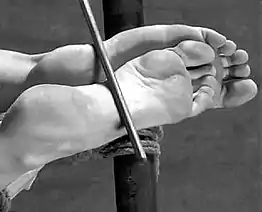
The soles of a barefoot person also serve as a specific target for corporal punishment, commonly referred to as "bastinado" (foot whipping). This method is mainly used in the context of penal functions while the receiving person is usually held in a situation of imprisonment or custody.
The practice of foot whipping is still officially employed in several Middle Eastern nations where the term falaka is customary. This kind of beating was also frequently practiced in Western countries until the middle of the 20th century, where it is generally referred to as "Bastonade". Among others, it was common in German territories, where it was employed until the end of the Nazi-era, mainly within the reformatory and prison system. In certain facilities it continued to be used up until the 1950s.[82][83][84][85]
The beatings are usually aimed at the vaults of the foot, not directly hitting the bone structure of the balls and the heels. The vaults are highly pain-sensitive due to the tight clustering of nerve tissue in that area.
As bastinado usually causes a high amount of suffering for the receiving person while physical evidence remains mostly undetectable after a certain time, it is often used for interrogation purposes in certain countries as well.[86]
Arts and entertainment
Many singers and dancers perform on stage barefoot. The classical dance of Cambodia had its roots in the holy dances of the legendary seductresses (apsaras) of ancient Cambodia and attained its high point during the Angkor period in its interpretations of the Indian epics, especially the Ramayana. Cambodian dancers were well-born women of the king's harem and danced barefoot, with the feet turned outwards and the legs slightly bent at the knee to cushion the movements of the upper body. The unimpeded movement of the foot was essential to the art. When the land was invaded by the Thai, the dancers were taken to the Thai court, where their art was adapted and continued to flourish.[87][88]
The barefoot dance movement of the early 20th century challenged the received laws of classical dance and the broader laws of social decorum. For decades, the bare foot had been perceived as obscene, and no matter how determined barefoot dancers were to validate their art with reference to spiritual, artistic, historic, and organic concepts, barefoot dancing was inextricably linked in the public mind with indecency and sexual taboo. In 1908, Maud Allan shocked and fascinated London theatre-goers with her barefoot dance of desire in Salome, and scandalous tributes positioned her as the embodiment of lust. For many, barefoot dancing represented not only the freedom and horror of modern sexuality but the progress and decline of high culture.[89]
.jpg.webp)
Californian Isadora Duncan revolutionized dance in the Western world by jettisoning the tutu and the pointe shoe of classical ballet and scandalized audiences by performing works of her own choreography in flowing draperies and bare feet. She anticipated the modern women's liberation movement by urging women to rid themselves of corsets and matrimony.[90] Duncan divorced the bare foot from perceptions of obscenity and made a conscious effort to link barefoot dancing to ideals such as "nudity, childhood, the idyllic past, flowing lines, health, nobility, ease, freedom, simplicity, order, and harmony". She believed her utopian dance vision and program would ameliorate the perceived ills of modern life and restore the world to the imagined perfection of Ancient Greece.[89]
The 1954 film The Barefoot Contessa tells the fictional story of Maria Vargas (portrayed by Ava Gardner), a Spanish cabaret dancer of simple origins who frequently went barefoot. She was cast in a movie by writer and director Harry Dawes (portrayed by Humphrey Bogart) and became a major star. In 1978, Ina Garten purchased a specialty food store in The Hamptons named Barefoot Contessa, after the movie. She liked the name because it went well with her simple and elegant cooking style. She sold the store in 1999 and wrote her first book, The Barefoot Contessa Cookbook, which became one of the best-selling cookbooks of the year. She would go on to write more cookbooks and, in 2002, started production of a television show on the Food Network, also named the Barefoot Contessa, which continues to run.[91]
.jpg.webp)
In the latter half of the 20th century, many singers, primarily females, have performed barefoot, a trend that continues in the early 21st century. One of the first singers to become well known for singing barefoot on stage was Sandie Shaw, who became known as the "Barefoot Pop Princess of the 1960s."[92] Jimmy Buffett is known for performing barefoot at concerts, promoting an island/beach bum lifestyle.[93] Cesária Évora of Cape Verde was known as the "Barefoot Diva" for her habit of performing without shoes.[94]
Health implications
_(B)_Adult_foot_that_has_never_worn_shoes%252C_(Right)_(A)_Foot_of_a_boy_who_has_worn_shoes_for_just_a_few_weeks._Plaster_casts.jpg.webp)
There are risks and benefits associated with going barefoot. Footwear provides some protection from puncture wounds from glass, nails, rocks, or thorns as well as abrasions, bruises, heat burns, electrical shock, and frostbite—but studies of people who habitually walk barefoot have consistently found that these problems are minimal, with only about 0.89% of barefoot people having any kind of foot complaint linked to walking barefoot (including temporary conditions such as abrasions) or having the tops of the feet uncovered. Feet that have never worn shoes rarely exhibit problems such as bunions, corns, and "fallen arches",[95][96] are not prone to more than ordinary foot eversion on standing and walking due to the associated weakness or stiffness of the joints of the foot and weakness of the muscles controlling them,[97] as well as having a much reduced incidence of problems such as callouses.[98]
Walking barefoot results in a more natural gait. People who are used to walking barefoot tend to land less forcefully, eliminating the hard heel strike and generating much less collision force in the foot and lower leg.[99] A 2006 study found that shoes may increase stress on the knee and ankle, and suggested that adults who walked barefoot may have a lower rate of osteoarthritis,[100] although more study is required to elucidate the factors that distribute loads in shod and barefoot walking. A 2007 study examined 180 modern humans and compared their feet with 2,000-year-old skeletons. They concluded that, before the invention of shoes, humans overall had healthier feet.[99] A 1991 study found that children who wore shoes were three times more likely to have flat feet than those who did not, and suggested that wearing shoes in early childhood can be detrimental to the longitudinal arch of the foot.[95] Children who habitually go barefoot were found to have stronger feet, with better flexibility and mobility, fewer deformities like flat feet or toes that curve inwards, and fewer complaints.[101] Walking barefoot enables a more natural gait, eliminating the hard heel strike and instead, allowing for a rocking motion of the foot from heel to toe.[99] Similarly, barefoot running usually involves an initial forefoot strike, instead of on the rear of the foot, generating smaller collision forces.[1]
Since there is no artificial protection of the bare foot, some of the possible issues include cuts, abrasions, bruises, or puncture wounds from glass, nails, rocks, or thorns, as well as poisonous plants, animals, or parasites that can enter the body through the cuts on an injured bare foot.[102] In people who are not habitually barefoot, athlete's foot is spread by fungal spores coming into contact with skin that has been weakened and made moist. The fungus is known to only affect around 0.75% of habitually barefoot people in one study and can be prevented by reducing shoe use and keeping the feet dry, particularly after walking through a damp environment where people communally walk barefoot as the fungus only develops under the right conditions, such as when people fail to properly dry their feet after swimming or showering and then put on shoes. Wearing shoes such as flip flops or sandals in these areas can reduce the risk.[103] As such, the fungus is very unlikely to develop on a person who goes barefoot all the time.
The hookworm parasite, found only in warm, moist climates where human feces contaminated with hookworm larvae has been left in places where it might come into contact with human skin, can burrow through a bare human foot (or any part of the body that comes into contact with it).[104] However, as the parasite tends to occur mainly in mud and cesspools, its spread cannot be stopped by most standard shoes since the larvae can penetrate fabric and small holes. The parasite may spread through contaminated material coming into contact with any part of the body, such as through flecks of mud splashing on an ankle or leg.[105] The hookworm parasite is relatively mild, has few symptoms, and can pass completely unnoticed when the infestation level is low enough. Since the hookworm infection is very cheap and easy to treat, and since it requires infected feces to come into contact with human skin within a particular time period, eradicating hookworm is mainly a matter of hygiene (including the building of proper toilet and waste-disposal facilities) and mass-treatment. In very cold weather, shoes can provide thermal insulation, protecting against frostbite.
Issues that can develop as a result of someone who has always worn shoes going barefoot include calf pain or Achilles tendinitis or plantar fasciitis due to shortening of the Achilles tendon and the foot being underdeveloped, due to regular use of shoes. A careful transition eases or remove symptoms, which quickly vanish as the foot adapts.[106][107] Blisters on the feet may occur in the first few weeks of going barefoot, until the skin has become more robust.[106] Individuals with diabetes or other conditions that affect sensation in the feet are at greater risk of injury while barefoot. The American Diabetes Association recommends that diabetics wear shoes and socks at all times.[108]
Laws
In the United States, there have been myths that regulations require the wearing of footwear. In the United States, during the period of the counterculture movement of the 1960s, business establishments would deny admittance to barefoot hippies arguing that health regulations required that shoes be worn.[109] This led to a belief by many in nonexistent OSHA or local health department regulations preventing people from going to stores, restaurants, and other establishments without shoes. However, those regulations that exist apply only to employees and not customers.[110] Specifically, the United States Occupational Safety and Health Administration requires employers to "ensure that each affected employee uses protective footwear" when there is a danger of foot injuries due to falling or rolling objects, objects piercing the sole of an employee's foot, and where an employee's feet may be exposed to electrical hazards.[111] Additionally, employee footwear, where required by OSHA, must comply with one of the standards described in OSHA's regulations.[111] State and local laws may dictate when and where an employee must wear shoes.[111]
Some people speculate that driving barefoot increases the risk of an accident if bare feet slip off the pedals.[112] It is legal throughout the United States, Canada, and the United Kingdom to drive barefoot.[112][113][114] However, in some US jurisdictions, police officers may ticket a driver for other things if the fact that they were driving barefoot or in flip-flops/high heeled shoes hindered their driving and/or resulted in an accident.
Sports and recreation
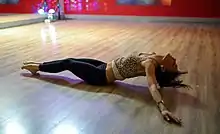
There are several recreational activities one can participate in while barefoot. Those involved in water sports such as swimming and water polo almost always participate barefoot due to the difficulty of swimming with footwear.
Other common activities performed barefoot include yoga, pilates, hiking, running, driving, water skiing, touch rugby, soccer, beach volleyball, surfing, tubing, gymnastics, Slacklining, and martial arts. Wrestling can be done barefoot. Although most modern Greco-Roman and WWE wrestlers wear shoes, sumo wrestling, Yağlı güreş (oil or "Turkish" wrestling), and mud wrestling are commonly done while barefoot. Fijian wrestler Jimmy "Superfly" Snuka of the WWE has wrestled barefoot as well.[116] American football is not traditionally a barefoot sport, though several placekickers have preferred to kick barefoot, including Tony Franklin of the Philadelphia Eagles and Rich Karlis of the Denver Broncos.[117][118] The two schools of thought involved in barefoot placekicking were that the lack of a shoe provided the kicker with a better "feel" for the ball and greater control over its trajectory. The second theory is that shoes and socks absorbed kinetic energy, and kicking flesh-to-leather created more torque.[119]
Hiking
People of all ages all over the world can participate in barefoot hiking, gathering for walks through forest and hiking trails sans footwear. Barefoot hikers claim that they feel a sense of communion with the earth and enjoy the sheer pleasure of feeling more of the world with their feet.[120] There are several clubs throughout North America practicing regular barefoot hikes, including the Barefoot Hikers of Minnesota, Seattle Barefoot Hikers, East Bay Barefoot Hikers, the Barefoot Hikers and Grass Walkers of Greater Kansas City, and the Barefoot Hikers of Connecticut.[120][121][122] This is in part also undertaken to be reminiscent of former slaves, who were often forced to remain barefoot at all times (see above).[123][124] Two sisters, Lucy and Susan Letcher, hiked approximately two-thirds of the 2,175-mile (3,500 km) Appalachian Trail barefoot from June 21, 2000, to October 3, 2001.[125][126] On November 12, 2010, 2,500 people in Mahabubnagar, India, participated in a barefoot walk, which was recognized by Guinness World Records as the world's largest.[127]
In European nations, including Austria, Denmark, France, Germany, Hungary, Switzerland, and the United Kingdom, there are barefoot parks or walks.[120][128][129] These parks are kept clean and maintained on a regular basis, so that barefoot hiking can be done in an environment suitable for people who are habitually shod. Barefoot parks usually include a lot of adventure stations, allowing visitors to experience the feeling of soil textures underfoot; to wade through rivers, mud, brooks, or ponds; and to exercise foot gymnastics, balancing, and climbing. The Barfußpfad (barefoot trail) at Bad Sobernheim in Germany attracts over 100,000 visitors annually and has seen approximately 1 million visitors since its inception in 1999.[130]
This concept was first developed in the 19th century by Sebastian Kneipp, one of the founders of the Naturopathic medicine movement. He believed that applying your feet to a range of natural stimuli would have therapeutic benefits. This is related to the ancient practice of reflexology, practiced in China for thousands of years for relaxation and to promote longevity.[131]
Seoul, South Korea, has 158 barefoot parks, allowing people to relax in a natural environment.[132]
Running
Many leisure and competitive runners have been known to run barefoot, including well-known athletes Zola Budd of South Africa and Abebe Bikila of Ethiopia.[133] Todd Ragsdale, of Talent, Oregon, set the world record (pending confirmation by Guinness World Records) for the longest distance run barefoot on June 5, 2010, as part of the Relay for Life fundraiser for the American Cancer Society. He logged 102 miles (164 km), or 413 laps on the South Medford High School track, barefoot.[134] The fastest person to run 100 meters (325 feet) on ice while barefoot is Nico Surings of Eindhoven, Netherlands, who ran that distance in 17.35 seconds on December 8, 2006.[135] Laboratory studies suggest that, due to the lack of extra weight on the feet, the energy cost of running barefoot is reduced by 4%, resulting in lower oxygen consumption.[133] There is evidence that wearing traditional shoes while running leads to heel strike gait that, in turn, leads to higher impact as well as a greater risk of injury.[1] Barefoot running encourages the runner to switch to forefoot strike and may reduce the risk of knee damage.
Barefoot running can be dangerous, especially to runners who do not adequately prepare or give their feet time to adapt to the new style. Many injuries are possible, such as injuries to the Achilles tendon or plantar fascia, or stress fractures in the metatarsal bones or lower leg. Barefoot runners who do not prepare their bodies could provide, "a stimulus plan for podiatrists, orthopedists, and physical therapists."[136]
The official position on barefoot running by the American Podiatric Medical Association states that there is not enough research on the immediate- and long-term benefits of the practice and that individuals should consult a podiatrist with a strong background in sports medicine to make an informed decision on all aspects of their running and training programs.[137]
One alternative to barefoot running is to wear thin-soled shoes with minimal padding, such as moccasins, plimsolls, or huaraches, which result in similar gait to going barefoot but protect the skin and keep dirt and water off.[138] Some modern shoe manufacturers have recently designed footwear to maintain optimum flexibility while providing a minimum amount of protection. Such shoes include the shoes made by Vibram FiveFingers,[139][140] Vivobarefoot,[141] and Nike's Nike Free shoes.[142] Sales of minimalist running shoes have grown into a US$1.7 billion industry. Sales of Vibram FiveFingers alone grew from US$450,000 in 2006 to US$50 million in 2011.[143]
Water skiing
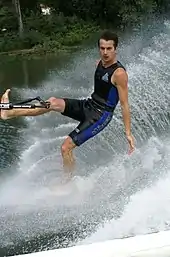
Barefoot skiing originated in Winter Haven, Florida, in 1947, when slalom skier A.G. Hancock tried to step off his ski.[144] The same year, in Cypress Gardens, Florida, competitive skier Richard Downing Pope, Jr., became well known in the sport of barefoot skiing.[145] The first barefoot skiing competition was held three years later, at the 1950 Cypress Gardens Dixie Championships.[146] In 1978, skiers from ten nations competed in the first World Barefoot Championships in Canberra, Australia. The same year, the American Barefoot Club (ABC) was formed, which governs competitive barefoot skiing events in the United States.[144]
Skateboarding
Early skateboarders rode barefoot, preferring foot-to-board contact and emulating surfing moves.[147][148][149] The plastic penny board is intended to be ridden barefoot, and Penny Skateboards have promoted the riding of the board barefoot by selling T-shirts and stickers.[150][151] They have also posted social media posts encouraging barefoot riding,[152][153] particularly in summer.[154] The Hamboard, a surfboard style board, is also intended to be ridden barefoot. Barefoot skateboarding has been witnessing a revival in recent times.[155] Many modern skateboarders skate barefoot, especially in summer and in warmer countries like Australia, South Africa, and parts of South America.
See also
- Sole (foot)
- Shoe
- Ötzi
- Barefoot doctor
- Barefoot in the Park (film)
- Colton Harris-Moore (also known as the "Barefoot Bandit")
References
- Lieberman, D. E.; Venkadesan, M.; Werbel, W. A.; Daoud, A. I.; d'Andrea, S.; Davis, I. S.; Mang'Eni, R. O.; Pitsiladis, Y. (2010). "Foot strike patterns and collision forces in habitually barefoot versus shod runners". Nature. 463 (7280): 531–35. Bibcode:2010Natur.463..531L. doi:10.1038/nature08723. PMID 20111000. S2CID 216420.
- "Biomechanical Differences Between Different Foot Strikes". Biomechanics of Foot Strikes & Applications to Running Barefoot or in Minimal Footwear. Daniel Lieberman. Retrieved April 11, 2018.
- Scarpa, R; Dorner, T. (1988). Barefoot water skiing: an illustrated guide to learning and mastering the sport. World Publications, Incorporated. p. 161. ISBN 978-0-944406-01-4.
- Wallack, R.M. (2009). Run for Life: The Anti-Aging, Anti-Injury, Super-Fitness Plan to Keep You Running to 100. Sky Horse Publishing. p. 34. ISBN 978-1-60239-344-8.
barefooter.
- "Unearthing the First Spartan Boys where not allowed to wear shoes to toughen their feet and allow stronger dexterity in their toes Olympics". npr.org. NPR. July 19, 2004. Archived from the original on July 28, 2010. Retrieved July 1, 2010.
- Frazine, Richard Keith (1993). The Barefoot Hiker. Ten Speed Press. p. 98. ISBN 0-89815-525-8.
- "77 Interesting Facts About Weddings". randomhistory.com. Archived from the original on July 23, 2010. Retrieved July 1, 2010.
- "Dangerous Elegance: A History of High-Heeled Shoes". randomhistory.com. Archived from the original on July 28, 2010. Retrieved July 1, 2010.
- Newman, Ruth I. (December 22, 2002). "Ozarks Women: Ignorant, Barefoot, and Pregnant?". West River Valley Historical Quarterly. Retrieved June 29, 2010.
- Hashinger, Edward H. (1961). "Arthur E. Hertzler: The Kansas Horse-and-Buggy Doctor". California Medicine. University of Kansas Press. 95 (3): 204. PMC 1574475.
- Peck, Joseph H. (May 21, 1958). "It's All Right to Keep Her Happy, But, Men, Don't Do Her Chores". Eugene Register-Guard.
- Ravitch, Diane (2000). The American reader: words that moved a nation. HarperCollins. pp. 140–43. ISBN 0-06-273733-3.
- Wheaton, Wil (2004). Dancing Barefoot. Monolith Press. p. 120. ISBN 0-596-00674-8.
- DeMello, Margo (2009). Feet and Footwear: A Cultural Encyclopedia. Macmillan. pp. 30–32. ISBN 978-0-313-35714-5.
- Lin, You Hsueh (February 13, 2010). "Thai monk walks million miles on barefoot". AsiaOne News. Retrieved July 1, 2010.
- "Mayo Mountain Rescue Team appeal to pilgrims for safety on holy mountain". Castlebar News. July 24, 2006. Retrieved June 29, 2010.
- "Mosque etiquette". Southeast Asia travel. Retrieved August 10, 2012 – via about.com.
- "Worship in Hindu temples". pujaonline. Archived from the original on June 25, 2012. Retrieved August 10, 2012.
- "Barefoot Bush pays tribute to Mahatma". The Times of India. March 3, 2006. Retrieved June 29, 2010.
- Willey, David. "Firewalking Myth vs Physics". University of Pittsburgh. Archived from the original on June 6, 2010. Retrieved June 29, 2010.
- "Season of the shoeless". Theaustralian.com.au. Retrieved November 27, 2015.
- "McDonald's gets set for summer with launch of 'Do Summer' campaign via DDB Sydney". Campaignbrief.com Australia. Retrieved November 27, 2015.
- "Lord Howe Island Community Strategy" (PDF). Lhib.nsw.gov.au. Retrieved November 27, 2015.
- James, Steve (July 8, 2019). "Australia walk barefoot around Edgbaston to create 'positive energy' before World Cup semi-final with England". The Times.
- "10 Reasons Why the Indian Way of Sitting on the Floor and Eating is Good for Health". April 4, 2016.
- Doctor, Vikram (September 10, 2016). "How Indians took to using the ubiquitous dining table in films and at home". The Economic Times.
- Page, Emma (January 3, 2010). "Attack on shoeless Kiwis costs lecturer job". Stuff.co.nz. Retrieved November 27, 2015.
- "'Striking' number of Kiwis walk around barefoot". tvnz.co.nz. April 16, 2012. Archived from the original on June 14, 2015. Retrieved June 12, 2015.
- "Going naked: barefoot in New Zealand". Mccabe.net.nz. March 26, 2014. Archived from the original on May 28, 2014. Retrieved March 6, 2017.
- Murray, Danielle (January 15, 2014). "Bare feet soothing to the sole and the soul". NZ Herald. Life & Style – NZ Herald News. Retrieved November 27, 2015.
- "Schedule: National Guidelines on School Uniform". Education.gov.za. Retrieved November 27, 2015.
- "Summer feet tips". Nhs.uk Choices. April 14, 2014. Retrieved November 27, 2015.
- "Gadsden Times". April 23, 1969.
- Schwartz, Johannes (2018). Weibliche Angelegenheiten - Handlungsräume von KZ-Aufseherinnen in Ravensbrück und Neubrandenburg (translation: Female matters - the extent of power wielded by overseers in Ravensbrück and Neubrandenburg. Hamburger Edition. pp. marginal no. 286. ISBN 9783868549287.
- Saidel 2006.
- Schulte, Jan Erik (2005). Konzentrationslager im Rheinland und in Westfalen 1933-1945. p. 157. ISBN 9783506717436. Retrieved March 25, 2013.
- Arbeitserziehungslager Fehrbellin:Zwangsarbeiterinnen im Straflager der Gestapo (translation: Work education camp Fehrbellin - female forced laboureres in the Gestapo punishment camp), S. 26ff.
- USMC Martial Arts Gray Belt Instructor Manual DSN 378-646, p. 38.
- "The shoe as a dangerous weapon". Rechtslupe (in German). September 8, 2015. Retrieved June 25, 2019.
- "Dangerous weapons". www.hrr-strafrecht.de/ (in German). April 3, 2002. Retrieved June 25, 2019.
- "The shoed foot, a dangerous weapon". sokolowski.org (in German). November 10, 2010. Retrieved June 25, 2019.
- Blue Guardian Control Tactics Instructor Manual by Tom Gillis, published 2016. p. 54.
- Mills, Robert; Peterson, Lauren. "Police capture man who escaped from Tewksbury police station". The Sun. Lowell, Massachusetts. Retrieved September 16, 2014.
- "Long hours in a Harare jail". news.bbc.co.uk. BBC News. June 1, 2002. Retrieved July 18, 2012.
- "Biblical studies: Footwear". www.bibelwissenschaft.de (in German). Retrieved August 6, 2015.
- "Cape Town and Surrounds". westerncape.gov.za. Retrieved July 18, 2012.
- "Slavery in Brazil". Children in History. Retrieved July 18, 2012.
- "Chapter 6: The living conditions of the slaves". Life in the Shadows: Slavery and Slave Culture in Suriname. October 6, 2008. Retrieved July 18, 2012.
- Scheen, Von Thomas (October 31, 2008). "Niger: Ehemalige Sklavin erhält Entschädigung". faz.net (in German). Archived from the original on October 31, 2008. Retrieved August 23, 2017.
- Yue, Charlotte (1997). Shoes: Their History in Words and Pictures. New York City: Houghton Mifflin Company. pp. 46. ISBN 978-0-395-72667-9.
straights+shoes.
- A Falun Dafa practitioner in Guangxi Province of China. "The Chinese Prison System I Know". clearharmony.net.
- Meldrum, Andrew (May 12, 2002). "My night in Mugabe's stinking jail". the Guardian.
- "Zimbabwe's jails: full of human kindness?". GlobalPost.
- "Foreign Prisoners Support Service". phaseloop.com.
- "A Trip Inside Phuket Prison: Photo Special". Phuket Wan. Archived from the original on December 8, 2015. Retrieved November 27, 2015.
- "Open Minds, Closed Doors: Prison Education in Uganda". DI News. Archived from the original on November 29, 2014. Retrieved September 15, 2014.
- "Barefoot prisoners bury Uganda cult bodies". DeseretNews.com. March 20, 2000.
- Rosenthal, Robert J. (January 1982). "Inside a Ugandan Prison, a Nightmare Comes to Life". The Philadelphia Inquirer. Archived from the original on October 7, 2011. Retrieved September 15, 2014 – via byliner.com.
- "American Pastor Saeed Facing "Hell on Earth" in Iran's Evin Prison". American Center for Law and Justice. January 30, 2013.
- "Prison conditions in Pakistan". YouTube. December 31, 1969.
- "How One Woman Helped Reform a Notorious Indian Prison". YouTube. December 31, 1969.
- Kowene, Gaius (August 5, 2013). "allAfrica.com: Congo-Kinshasa: Meet 'Mr Human Rights'". allAfrica.com.
- Solomon, Erica (August 8, 2011). "'I Live Here' – Introducing the Boys of Kachere Juvenile Prison". The Huffington Post.
- "World's Toughest Prisons". The Voice of Russia's Global Discussion. Archived from the original on October 6, 2014. Retrieved September 15, 2014.
- "Cote d'Ivoire: When a sentence to jail can be a sentence to death". IRINnewsCote d'Ivoire – Droits de l'homme. May 17, 2005.
- "Life Funds for North Korean Refugees, an NGO". northkoreanrefugees.com.
- "ISIS removes shoes of captives". smh.com.au.
- "Australian addict welcomes 31-year prison term". smh.com.au. July 5, 2003.
- "Irish Australian man facing jail in Thailand". irishecho.com.au. Archived from the original on September 29, 2014. Retrieved September 15, 2014.
- "A Foreigner in a Thai Court". Thai Prison Life – ชีวิตในเรือนจำ. May 27, 2007.
- "B.C. pedophile, homeward bound after Thai prison term, arrested at Vancouver airport". The Globe and Mail.
- Olarn, =Kocha (January 23, 2013). "Thai court sentences activist to 10 years in prison for insulting king". CNN.
- "Extradition hearing for arms dealer postponed". taipeitimes.com. July 29, 2008.
- Schulte, Jan Erik (2005). Konzentrationslager im Rheinland und in Westfalen 1933–1945. Zwischen zentraler Steuerung und regionaler Initiative. ISBN 978-3506717436.
- "Brandenburgische Landeszentrale für politische Bildung" (PDF). Archived from the original (PDF) on November 26, 2013. Retrieved September 15, 2014.
- Riepl, Maggie (March 10, 2012). "DDR-Gefängnis Hoheneck: 'Das Unrecht verfolgt mich – bis an mein Lebensende'". Berliner Morgenpost. Berlin.
- "Prisoners' Rights". www.cliffsnotes.com. Archived from the original on May 22, 2016. Retrieved August 23, 2017.
- Butler, Anne M. (1999). Gendered Justice in the American West: Women Prisoners in Men's Penitentiaries. ISBN 978-0252068799. Retrieved March 22, 2013.
- Banks, Cyndi (2003). Women in Prison: A Reference Handbook. ISBN 978-1576079294. Retrieved March 22, 2013.
- Gordon Moris Bakken; Brenda Farrington (2003). Encyclopedia of Women in the American West. ISBN 978-0761923565. Retrieved March 22, 2013.
- Das verhexte Kloster: Nach den Akten dargestellt (trans. The bewitched cloister: portrayed according to official records) by Anton Memminger, published 1904. p. 137.
- "Wimmersdorf: 270 Schläge auf die Fußsohlen" [Wimmersdorf: 270 blows on the soles of the feet]. kurier.at (in German). Retrieved March 3, 2014.
- "Berichte über Folter in Kinder-Heim auf der Hohen Warte". krone.at.
- Torture and Democracy von Darius Rejali. S. 275.
- Ruxandra Cesereanu: An Overview of Political Torture in the Twentieth Century. pp. 124f.
- Torture and Democracy by Darius Rejali. pp. 275f.
- Colet, John; Joshua Eliot; Abigail Vertigan (2002). Cambodian Handbook. Footprint. p. 218. ISBN 1-903471-40-0.
- Brown, Ian (2000). Cambodia. Oxfam GB. p. 71. ISBN 0-85598-430-9.
- Benstock, Shari; Ferriss, Suzanne, eds. (2001). Footnotes: On Shoes. Rutgers University Press. pp. 276–78. ISBN 0-8135-2870-4.
- Needham, Maureen (2002). I See America Dancing: Selected Readings, 1685–2000. University of Illinois Press. p. 174. ISBN 978-0-252-06999-4.
- "Ina Garten (biography)". Food Network. Archived from the original on June 30, 2010. Retrieved July 10, 2010.
- Roberts, David (2006). British Hit Singles & Albums (19th ed.). London: Guinness World Records Limited. p. 495. ISBN 1-904994-10-5.
- Carter, Lauren (June 19, 2010). "Jimmy Buffett a god to lei persons". The Edge. Archived from the original on June 27, 2010. Retrieved July 1, 2010.
- "French honour for 'barefoot diva'". BBC News. February 9, 2009. Retrieved July 1, 2010.
- Rao UB, Joseph B (July 1992). "The influence of footwear on the prevalence of flat foot. A survey of 2300 children". J Bone Joint Surg Br. 74-B (4): 525–27. doi:10.1302/0301-620X.74B4.1624509. ISSN 0301-620X. PMID 1624509. S2CID 42355530.
- Sachithandam V, Joseph B (March 1995). "The influence of footwear on the prevalence of flat foot. A survey of 1846 mature persons". J Bone Joint Surg Br. 77-B (2): 254–57. doi:10.1302/0301-620X.77B2.7706341. ISSN 0301-620X. PMID 7706341. S2CID 537906.
- Hoffmann, P (October 1905). "Conclusions drawn from a comparative study of the feet of barefooted and shoe-wearing peoples" (PDF). J Bone Joint Surg Am. 2 (3): 105–36.
- Zipfel, B.; L.R. Berger (May 17, 2007). "Shod versus unshod: The emergence of forefoot pathology in modern humans?". The Foot. 17 (4): 205–213. doi:10.1016/j.foot.2007.06.002.
- Sternbergh, Adam (April 21, 2008). "You Walk Wrong". New York Magazine. Archived from the original on April 22, 2008. Retrieved June 26, 2010.
- Shakoor N, Block JA (2006). "Walking barefoot decreases loading on the lower extremity joints in knee osteoarthritis". Arthritis Rheum. 54 (9): 2923–27. doi:10.1002/art.22123. PMID 16947448. S2CID 11769504.
- Angier, Natalie (August 14, 1991). "Which Shoes Are Best For Children? Maybe None". The New York Times. Retrieved June 26, 2010.
- Staheli, LT (1991). "Shoes for children: a review". Pediatrics. 88 (2): 371–75. PMID 1861942.
- Hyde, Patricia. "Athlete's Foot". kidshealth.org. Retrieved July 1, 2010.
- "Hookworm Infection". Centers for Disease Control and Prevention. September 11, 2008. Archived from the original on March 1, 2000. Retrieved August 4, 2009.
- Trop, Am J. "Penetration by Infective Hookworm Larvae of the Materials Used in the Manufacture of Shoes". Archived from the original on February 23, 2013. Retrieved October 26, 2012. Cite journal requires
|journal=(help) - Quinn, Elizabeth. "Barefoot Running – The Pros and Cons of Going Shoeless". About.com. Retrieved June 26, 2010.
- Howell, Daniel (2010). The Barefoot Book. Hunter House. ISBN 978-1630266639.
- "Foot Care". American Diabetes Association. Archived from the original on November 7, 2011. Retrieved June 26, 2010.
- Miller, Joe (May 29, 2008). "Going barefoot". The News and Observer. Archived from the original on June 2, 2008. Retrieved August 5, 2009.
- "Bare Feet and OSHA". barefooters.org. January 7, 2006. Archived from the original on May 24, 2009. Retrieved August 5, 2009.
- Chow, Andrew (May 2, 2012). "Is Going Barefoot at Work a Step Too Far?". Reuters. Archived from the original on May 8, 2012. Retrieved May 2, 2012.
- Lawson, Alex (September 6, 2007). "Legal myths, rumors about driving barefoot busted". The Daily Vidette. Archived from the original on June 2, 2008. Retrieved August 5, 2009.
- "Q18: Is it legal to drive barefoot?". barefooters.org. July 13, 2004. Archived from the original on April 30, 2009. Retrieved August 5, 2009.
- Hernandez, Salvador (April 25, 2008). "HONK: The myth about driving barefoot". The Orange County Register. Archived from the original on September 7, 2015. Retrieved August 5, 2009.
- Traina, Jimmy (June 12, 2006). "Favorite Wrestlers of All Time". Sports Illustrated. Archived from the original on April 7, 2008. Retrieved July 10, 2010.
- Gehman, Jim (May 5, 2007). "Where Are They Now: PK Tony Franklin". Philadelphia Eagles. Archived from the original on June 19, 2010. Retrieved June 27, 2010.
- Moss, Irv (January 27, 2009). "Karlis a standout as barefoot kicker". Denver Post. Retrieved June 27, 2010.
- Klosterman, Chuck (October 16, 2006). "A brilliant idea! (For now)". ESPN. Retrieved June 27, 2010.
- Todras-Whitehill, Ethan (September 22, 2006). "Footloose and Boot Free: Barefoot Hiking". The New York Times. Retrieved June 26, 2010.
- Pauly, Brett (March 21, 1996). "Sole Survivors: New shoeless joes are hitting dusty trails around San Francisco Bay and beyond". Los Angeles Daily News. Archived from the original on October 29, 1996. Retrieved June 26, 2010.
- "Barefoot Hiking Groups". The Barefoot Hub. Retrieved April 16, 2015.
- Lanza, Michael (July 1995). "The Happy Hoofers". Yankee Magazine. Archived from the original on October 29, 1996. Retrieved June 26, 2010.
- "In Conn. barefoot hiking club, tenderfoots welcome". Hartford Courant. June 20, 2010. Retrieved June 28, 2010.
- Belisle, Richard F. (August 5, 2009). "Barefoot hikers return to Appalachian Trail for book tour". The Herald-Mail. Archived from the original on June 10, 2009. Retrieved June 28, 2010.
- Letcher, Lucy; Letcher, Susan (2009). The Barefoot Sisters: Southbound. Stackpole Books. p. 474. ISBN 978-0-8117-3530-8.
- "Largest Barefoot Walk". Guinness World Records. Retrieved July 16, 2012.
- Owen, Wena Alun (March 20, 2009). "Challenge senses on barefoot walk". BBC News. Retrieved June 26, 2010.
- "Public Barefoot Parks in Europe". barfusspark.info. Archived from the original on June 5, 2010. Retrieved June 26, 2010.
- "Fast eine Million Menschen". Allgemeine Beitung (in German). November 25, 2009. Retrieved June 26, 2010.
- Wignall, Alice (March 25, 2008). "Get your socks off". The Guardian. Retrieved July 1, 2010.
- "158 barefoot parks in Seoul". seoul.go.kr. May 12, 2006. Archived from the original on February 18, 2013. Retrieved June 26, 2010.
- Warburton, Michael (September–December 2001). "Barefoot Running". Sportscience. 5 (3). Archived from the original on July 22, 2010. Retrieved June 27, 2010.
- Burke, Anita (June 8, 2010). "Todd Ragsdale endures The agony of the feet". Mail Tribune. Archived from the original on June 10, 2010. Retrieved July 1, 2010.
- "Fastest run 100 metres barefoot on ice". Guinness World Records. Retrieved July 1, 2010.
- Carey, Art (June 28, 2010). "Well Being: Running barefoot has not-so-obvious hazards". The Philadelphia Inquirer. Archived from the original on July 2, 2010. Retrieved July 2, 2010.
- "APMA Position Statement on Barefoot Running". American Podiatric Medical Association. Retrieved November 4, 2010.
- Hersher, Rebecca (January 27, 2010). "Perfect Landing". Harvard University. Archived from the original on July 19, 2011. Retrieved June 26, 2010.
- "Vibram FiveFingers Named A "Best Invention of 2007" by Time Magazine". trailspace.com. November 12, 2007. Retrieved June 26, 2010.
- Gauthier, Al. "Review – Vibram FiveFingers KSO Trek". Living Barefoot. Archived from the original on June 19, 2010. Retrieved June 26, 2010.
- Woollard, Deirdre (March 13, 2010). "EVO Shoes Offer A Close-To-The-Earth Experience". Luxist. Archived from the original on May 25, 2010. Retrieved July 1, 2010.
- Cortese, Amy (August 29, 2009). "Wiggling Their Toes at the Shoe Giants". The New York Times. Retrieved July 1, 2010.
- Mirshak, Meg (July 19, 2012). "Minimalist-style shoes mimic running barefoot". Augusta Chronicle. Retrieved July 22, 2012.
- Oleksy, Walter G. (2000). Barefoot Waterskiing. Capstone Books. pp. 13–15. ISBN 0-7368-0480-3.
- "Richard Downing Pope, Jr". Water Ski Hall of Fame. Archived from the original on June 19, 2010. Retrieved June 27, 2010.
- Poyet, Philippe (May 13, 2009). "The History of Barefooting". American Barefoot Waterski Club. Archived from the original on October 27, 2010. Retrieved June 27, 2010.
- Marcus, Ben (2011). The Skateboard: The Good, the Rad, and the Gnarly: An Illustrated History. ISBN 978-0760338056. Retrieved November 27, 2015.
- Skateboarding, Space and the City: Architecture and the Body By Iain Borden. Goggle Books.
- Weyland, Jocko (2002). The Answer is Never: A Skateboarder's History of the World. Grove Press. p. 21. ISBN 978-0802139450. Retrieved November 27, 2015.
- "penny stickers". Pennyskateboards.com. Archived from the original on July 26, 2015. Retrieved November 27, 2015.
- "Blue Bare Foot Shirt". pennyskateboards.com. Archived from the original on June 13, 2015. Retrieved August 23, 2017.
- "Instagram". Instagram. Retrieved November 27, 2015.
- "Instagram". Instagram. Retrieved November 27, 2015.
- "Instagram". Instagram. Retrieved November 27, 2015.
- "BLAHskateboards: filmproject". Blahfilmproject.tumblr.com. Retrieved November 27, 2015.
Bibliography
- Saidel, Rochelle G. (2006). The Jewish Women of Ravensbrück Concentration Camp. Terrace Books. ISBN 978-0299198640. Retrieved March 26, 2013.
External links
 Media related to Barefoot park at Wikimedia Commons
Media related to Barefoot park at Wikimedia Commons